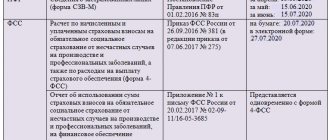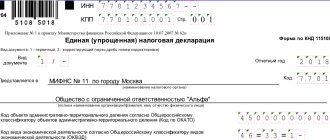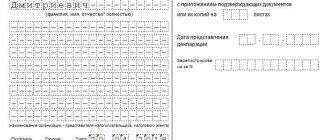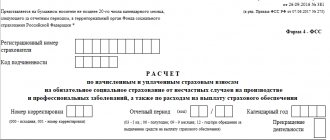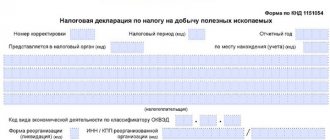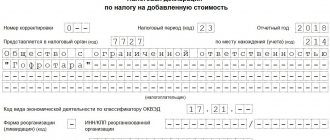In 2021, legal entities with employees will have to report to the Social Insurance Fund four times - submit report form 4-FSS based on the results of 2021, the first quarter, half a year and nine months.
Form 4-FSS is submitted only for contributions from accidents. For all other types of contributions, you must report to the Federal Tax Service using the approved payment form.
Reports to the FSS are submitted in the form approved by Order of the FSS of the Russian Federation dated 06/07/2017 No. 275. When preparing a report in 2021, you should check the relevance of the form.
Submit electronic reports via the Internet. The Kontur.Extern service gives you 3 months free of charge!
Try it
Forms for submitting reports to the Social Insurance Fund
An electronic report in Form 4-FSS is submitted by organizations where the average number of employees exceeds 25 people. The same applies to newly created or reorganized companies (Article 22.1 of the Federal Law of July 24, 1998 No. 125-FZ).
Individual entrepreneurs who have entered into employment contracts with employees are also required to pay contributions and submit reports in Form 4-FSS. The deadlines for submitting the report are the same as for organizations.
Submit electronic reports via the Internet. The Kontur.Extern service gives you 3 months free of charge!
Try it
Please note that if an individual entrepreneur has concluded a civil contract with an employee, then he is not required to register with the Social Insurance Fund, pay contributions and submit reports.
Where should the reporting form be submitted?
Companies that do not have separate divisions submit their calculations to the territorial office of the Social Insurance Fund at their location.
If there are any discrepancies, the calculation is transferred to:
Subscribe to our newsletter
Yandex.Zen VKontakte Telegram
- at the location of a separate division, if it has a current account with a banking institution and it independently calculates and pays wages to its employees;
- the location of the head office, if the unit does not have a bank account and is not involved in the calculation and payment of salaries, or if a separate unit is located abroad.
Entrepreneurs register with the territorial body of the Social Insurance Fund at their place of registration, therefore, the report must be sent there.
Fine for late submission of reports to the Social Insurance Fund
If the 4-FSS is not submitted on time, the organization may be held liable under Art. 26.30 of the Federal Law of July 24, 1998 No. 125-FZ. That is, 5% of the amount of contributions accrued for the last three months of the reporting or billing period, for each full and partial month from the date established for submitting the calculation. In this case, the fine should not exceed 30% of this amount and be less than 1,000 rubles.
In addition, for violation of the procedure for submitting reports - for example, when the number of employees at the enterprise is more than 25 people, but the report was submitted in paper form - a fine of 200 rubles is provided.
Composition and procedure for filling out the form
Currently, Form 4-FSS is in force, approved by order of the fund dated September 26, 2016 No. 381. The same document also provides instructions for filling out the calculation. In accordance with it, it is mandatory to fill out the following sections: title page, Table 1, Table 2 and Table 5. Data in the remaining tables are indicated if there are relevant transactions in the reporting period:
- Table 1.1 – if personnel are temporarily sent to another employer (contributions are calculated according to its tariffs);
- Tables 3 and 4 - if there were cases of occupational diseases or injuries.
Let's take a closer look at the current Form 4-FSS and instructions for filling it out in 2021.
Free accounting services from 1C
Title page
On the first sheet the following fields are filled in:
- number of the policyholder in the Social Insurance Fund;
- subordination code – 5-digit code of the FSS department;
- adjustment number – for initial submission “000”;
- reporting period. The field is filled out as follows: if the form is submitted for 1 quarter, “03” is written in the first two cells, “06” for six months, “09” for nine months, “12” for a year. If the form is submitted for reimbursement of expenses, then the serial number of the application in the format “01” is entered in the last two cells.
- reporting year;
- termination of activity - if the policyholder is liquidated, the letter “L” is indicated;
- name of the company or name of the entrepreneur;
- main codes – TIN, KPP (for organizations), state registration number, OKVED. If the enterprise is budgetary, the corresponding code is entered;
- telephone and address;
- average number of personnel, highlighting disabled people and people employed in hazardous and hazardous industries;
- number of calculation pages and applications.
In the lower block on the right, the policyholder confirms the accuracy of the information entered, puts his signature and indicates the date. Here you need to reflect:
- code of the person who signs the document: 1 – director of the company or the entrepreneur himself, 2 – authorized representative, 3 – legal successor;
- Full name of the person signing the form;
- in the last lines - details of the power of attorney (if the signature is signed by a representative).
Table 1
Let's look at how to fill out the first table. It calculates the basis for calculating contributions. Lines 1-4 are filled out in total for the period and broken down for each of the last three months. They need to indicate:
- amounts of payments to individuals;
- non-contributory amounts;
- base, that is, the difference between these indicators;
- payments in favor of disabled people.
In lines 5-9 the insurance rate is calculated:
- 5 – basic tariff;
- 6 – discount for it;
- 7 – allowance;
- 8 – date of assignment of the allowance;
- 9 – final tariff amount.
Table 1.1
If during the period the policyholder sent its employees to other companies, then in Table 1.1 it reflects the data that is needed to calculate premiums for them. Information is entered line by line for each entity where workers were sent. Columns 1-5 of the table indicate:
- 1 – serial number of the record;
- 2 – registration number of the receiving entity;
- 3 – his TIN;
- 4 – its OKVED code;
- 5 – number of sent workers.
In columns 6-12 the base for insurance premiums is calculated. The following information is entered:
- 6 – base from the beginning of the period;
- 7 – database for disabled people;
- 8-13 – breakdown of amounts for each of the last three months, highlighting amounts for disabled people.
Column 14 indicates the base tariff, and column 15 the final tariff (including discounts and surcharges).
table 2
This table, consisting of two parts, reflects calculations for contributions “for injuries”. The following information is entered on the left side of the table:
- 1 – debt of the policyholder to the Social Insurance Fund at the beginning of the period;
- 1.1 – debt to the liquidated person;
- 2 – the amount of contributions accrued for payment: at the beginning of the period, in total for the last 3 months and broken down by month;
- 3 – additionally accrued contributions after inspections;
- 4 – amounts that the FSS did not accept for offset;
- 5 – accrued contributions for previous periods;
- 6 – amounts of compensation received from the Social Insurance Fund;
- 7 – amounts returned to the fund or offset;
- 8 – the sum of all the above indicators;
- 9 – fund debt at the end of the period, including: 10 – amount of excess expenses;
- 11 – the amount of overpayment of contributions by the policyholder.
The second part of the table reflects the fund's debt to the policyholder. Here you need to reflect line by line:
- 12 – debt at the beginning of the period, including:
- 13 – due to excess costs,
- 14 – due to overpayment;
- 14.1 – amount of debt from the Social Insurance Fund to the policyholder;
- 15 – insurance costs “for injuries”: total for the period, for the last 3 months in one amount and broken down for each of them;
- 16 – the amount of contributions paid at the beginning of the period and for the last 3 months in a single amount, as well as for each month separately (you must indicate not only the amount, but also the number and date of payment);
- 17 – the amount of debt that the Social Insurance Fund wrote off;
- 18 – the amount of the insured’s debt for the period (you need to add up the indicators from lines 12, 14.1, 15-17);
- 19 – debt due to the policyholder at the end of the period;
- 20 – arrears on contributions (included in the amount of line 19).
Tables 3 and 4
Table 3 calculates the amounts of benefits for occupational diseases and accidents, if any. The lines need to reflect:
- 1 – sick leave for accidents, including part-time workers (line 2) and persons who were injured in another organization (line 3);
- 4 – sick leave for occupational diseases, including part-time workers (line 5) and employees assigned to other insurers (line 6);
- 7 – payment for sanatoriums (in addition to annual leave), including for those injured on the territory of other employers (line 8);
- 9 – costs of paying for measures to reduce injuries and occupational diseases;
- 10 – the amount of expenses from lines 1, 4, 7 and 9;
- 11 – the amount of benefits that are accrued but not paid.
When filling out Table 3 on lines 1-8, not only the amount, but also the number of days is indicated.
Table 4 reflects the number of people affected during the reporting period. The following data is entered into the lines:
- 1 – victims of accidents;
- 2 – including the dead;
- 3 – victims of occupational diseases;
- 4 – total number of victims (line 1 + term 3);
- 5 – including the number of victims who received temporary disability.
Table 5
When filling out Table 5 of Form 4-FSS, you must indicate the results of a special assessment of working conditions. In line 1, in columns 3-6, the results of the SOUT are entered:
- 3 – total number of jobs;
- 4 – the number of places in respect of which a special assessment was carried out, including those classified as hazard classes 3 (line 5) and 4 (line 6).
In line 2, only columns 7 and 8 are filled in:
- 7 – the number of employees who must undergo medical examinations (harmful and dangerous working conditions);
- 8 – the number of employees who underwent such medical examinations at the beginning of the year.
How to prepare a 4-FSS report in electronic form
You can generate an electronic 4-FSS report in the Kontur.Extern system: select the “FSS” menu > “Create report”.
After that, select the type of report, reporting period and organization for which you want to submit the report and click on the “Create report” button. If you started filling out the report earlier, then by clicking the “Show report in the list” button you can open it for editing and sending.
To download a ready-made calculation from your accounting program, select the “FSS” menu > “Load from file”. The downloaded report can be viewed and, if necessary, edited by clicking on the “Download for editing” button.
After filling out the report, it will appear in the “FSS” > “All reports” section. Hover your cursor over the line with the desired report and select the required action.
After proceeding to send the report, select the certificate to sign and click on the “Check Report” button. If errors are found when checking the report, click on the “Open Editor” button, correct the errors and proceed to submit the report again.
If there are no errors, click on the “Proceed to Send” button.
After this, just click “Sign and Send”, and the system will upload the report to the FSS portal.
Next, you can track the status of the report - the control protocol and receipts for receiving reports will be sent directly to Extern.
When the status changes to “Receipt Received”, this means that the report has been submitted. The receipt can be opened and viewed, and saved if necessary. If the calculation status is “Submission Error,” it means that the calculation was not sent and you need to try again.
If the status is designated as “Decryption error,” the FSS was unable to decrypt the calculation or verify the electronic signature. Make sure you select the correct certificate to sign the payment and submit again.
The status “Format control error” indicates that the calculation has not been submitted. You need to correct the errors and resubmit the report. If the status is indicated as “Logical control error”, then a receipt with errors was received. The need to correct them must be reported to the FSS.
Submit electronic reports via the Internet. The Kontur.Extern service gives you 3 months free of charge!
Try it
